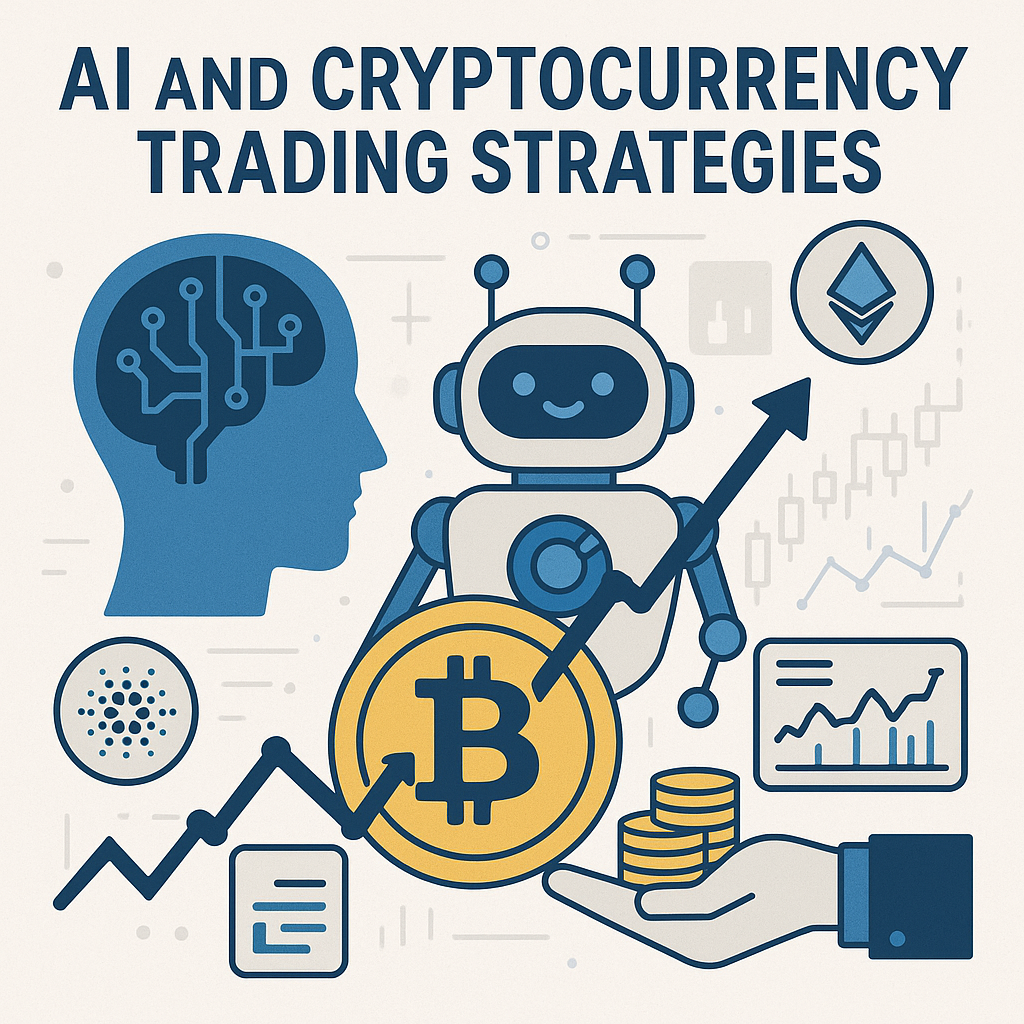In the rapidly evolving world of finance, the intersection of artificial intelligence and cryptocurrency trading has become a focal point for traders and investors alike. As digital currencies continue to capture global interest, AI trading systems are emerging as powerful tools, offering advanced strategies and insights.
From automated trading algorithms to machine learning in trading, these technologies are reshaping how we analyze and engage with the crypto market.
In this blog post, we will explore the latest cryptocurrency trends and strategies that leverage AI, providing a comprehensive guide for those looking to enhance their crypto investment strategies with the latest financial technology advancements.
Stay tuned as we delve into the cutting-edge world of trading bots and decentralized finance, and uncover how blockchain technology is influencing the future of crypto market analysis.
Table of Contents
Understanding AI Trading
AI trading is revolutionizing the cryptocurrency market. This section explores the fundamentals of AI trading, its benefits in the crypto sphere, and the challenges it presents.
What is AI Trading?
AI trading refers to the use of artificial intelligence algorithms to make trading decisions in financial markets, including cryptocurrencies. These systems analyze vast amounts of data to identify patterns and make predictions about market movements.
AI trading platforms use machine learning techniques to improve their performance continuously. They can process information from various sources, including news articles, social media, and market data, to make informed trading decisions.
One of the key advantages of AI trading is its ability to operate 24/7, capitalizing on opportunities in the always-open crypto market. This constant vigilance can lead to more profitable trades and better risk management.

Benefits of AI in Crypto
AI offers several advantages in cryptocurrency trading, enhancing both efficiency and profitability. These systems can analyze market trends and execute trades faster than human traders, often in milliseconds.
AI trading algorithms can identify complex patterns in crypto market data that might be invisible to human traders. This can lead to more accurate predictions of price movements and better-timed trades.
Risk management is another area where AI excels. These systems can monitor multiple cryptocurrencies simultaneously, adjusting positions based on real-time market conditions to minimize losses and maximize gains.
Emotional bias, a common pitfall in trading, is eliminated with AI systems. They make decisions based purely on data and predefined strategies, avoiding the psychological traps that often affect human traders.
Challenges of AI Trading
Despite its benefits, AI trading in cryptocurrencies faces several challenges. One major issue is the quality and reliability of data in the crypto market, which can be more volatile and less regulated than traditional financial markets.
Overfitting is another concern, where AI models become too specialized to historical data and fail to perform well in new market conditions. This requires careful model design and continuous refinement.
The “black box” nature of some AI algorithms can make it difficult for traders to understand and trust the decisions made by these systems. This lack of transparency can be a barrier to adoption for some investors.
Regulatory challenges also exist, as the use of AI in trading is still a relatively new field. As regulations evolve, AI trading systems may need to adapt to comply with new rules and standards.
Cryptocurrency Trends and Insights
The cryptocurrency market is dynamic and ever-changing. This section examines current trends, future predictions, and the impact of blockchain technology on the crypto landscape.
Current Market Trends
The cryptocurrency market has seen significant growth and evolution in recent years. One notable trend is the increasing institutional adoption of cryptocurrencies, with major companies and investment firms adding digital assets to their portfolios.
Decentralized finance (DeFi) has emerged as a significant force in the crypto world. These platforms offer financial services without intermediaries, using smart contracts on blockchain networks. The total value locked in DeFi protocols has grown exponentially.
Non-fungible tokens (NFTs) have also gained tremendous popularity. These unique digital assets, often representing art or collectibles, have opened new avenues for creators and investors in the crypto space.
Environmental concerns have led to a shift towards more energy-efficient cryptocurrencies and blockchain networks. This trend is likely to continue as sustainability becomes a key focus for the industry.
Future Predictions
Experts predict continued growth and maturation of the cryptocurrency market. Many anticipate increased regulation, which could bring more stability and legitimacy to the space, potentially attracting more institutional investors.
The integration of cryptocurrencies into traditional financial systems is expected to accelerate. This could include more widespread acceptance of crypto payments and the development of central bank digital currencies (CBDCs).
Technological advancements are likely to address current limitations in blockchain networks, such as scalability and interoperability issues. This could lead to faster, more efficient cryptocurrencies and expanded use cases.
The role of AI in cryptocurrency trading and management is expected to grow, with more sophisticated algorithms and predictive models being developed to navigate the complex crypto market.
Impact of Blockchain Technology
Blockchain, the technology underlying cryptocurrencies, is having far-reaching effects beyond digital currencies. Its decentralized, transparent nature is being applied to various industries, from supply chain management to healthcare.
In finance, blockchain is enabling faster, cheaper cross-border transactions and more efficient settlement systems. It’s also the foundation for innovative financial products in the DeFi space.
The concept of digital identity is being reimagined through blockchain technology. This could lead to more secure and user-controlled personal data management systems.
Blockchain’s potential for creating transparent, tamper-proof records is being explored in voting systems, potentially enhancing the integrity of democratic processes.
Automated Trading Systems
Automated trading systems are at the forefront of AI-driven cryptocurrency trading. This section explores trading bots, machine learning applications, and market analysis tools.
Introduction to Trading Bots
Trading bots are automated software programs that execute trades based on predefined criteria. In the cryptocurrency market, these bots can operate 24/7, capitalizing on opportunities around the clock.
Most trading bots use technical analysis indicators to make decisions. They can be programmed with various strategies, from simple arbitrage to complex trend-following algorithms.
One advantage of trading bots is their ability to remove emotional decision-making from trading. They stick to the strategy they’re programmed with, avoiding impulsive trades based on fear or greed.
However, it’s important to note that trading bots require careful setup and monitoring. They need to be regularly updated to adapt to changing market conditions and may not perform well in unexpected situations.
Machine Learning in Trading
Machine learning algorithms are increasingly being used in cryptocurrency trading to predict market movements and optimize trading strategies. These systems can analyze vast amounts of data to identify patterns and trends.
One application of machine learning is in sentiment analysis. By processing news articles and social media posts, these algorithms can gauge market sentiment and predict potential price movements.
Reinforcement learning, a type of machine learning where algorithms learn through trial and error, is being used to develop adaptive trading strategies that can evolve based on market conditions.
It’s worth noting that while machine learning can be powerful, it’s not infallible. These systems can be affected by biases in their training data and may struggle with unprecedented market events.
Crypto Market Analysis Tools
A wide range of tools are available for analyzing the cryptocurrency market. These include platforms for technical analysis, fundamental analysis, and on-chain metrics.
Technical analysis tools provide charts and indicators to help traders identify trends and potential entry or exit points. Many of these tools now incorporate AI to provide more advanced insights.
Fundamental analysis in crypto often involves examining factors like adoption rates, development activity, and regulatory news. AI-powered tools can aggregate and analyze this information to provide comprehensive market insights.
On-chain analysis tools examine data directly from blockchain networks. This can provide unique insights into network activity, wallet movements, and other metrics that can influence cryptocurrency prices.
Crypto Investment Strategies
Successful cryptocurrency investment requires careful strategy. This section covers risk management, opportunities in decentralized finance, and considerations for long-term versus short-term investment.
Risk Management Techniques
Risk management is crucial in the volatile cryptocurrency market. One fundamental technique is diversification, spreading investments across different cryptocurrencies to reduce overall risk.
Setting stop-loss orders is another important risk management tool. These automatically sell an asset when it reaches a certain price, limiting potential losses.
Position sizing is also key. This involves determining how much of your portfolio to allocate to each investment based on your risk tolerance and the asset’s volatility.
It’s essential to stay informed about market news and regulatory developments that could impact cryptocurrency prices. Many investors use AI-powered news aggregators to keep up-to-date.
Decentralized Finance Opportunities
Decentralized Finance (DeFi) offers new investment opportunities in the crypto space. These platforms allow users to lend, borrow, and earn interest on cryptocurrencies without traditional intermediaries.
Yield farming is a popular DeFi strategy where investors provide liquidity to decentralized exchanges in return for rewards. This can offer high returns but also comes with significant risks.
Decentralized lending platforms allow users to earn interest by lending their cryptocurrencies. These often offer higher rates than traditional savings accounts but lack the same regulatory protections.
It’s essential to thoroughly research DeFi platforms before investing, as the space is still relatively new and can be prone to smart contract vulnerabilities and other risks.
Long-term vs Short-term Investment
Cryptocurrency investors often debate between long-term holding (usually called “HODLing”) and short-term trading strategies. Long-term investors typically believe in the future potential of cryptocurrencies and are willing to weather short-term volatility.
Short-term trading aims to profit from price fluctuations. This approach requires more active management and a good understanding of technical analysis. AI trading systems are beneficial for short-term strategies.
A balanced approach might involve a core long-term holding complemented by a portion of the portfolio dedicated to short-term trading. This allows investors to benefit from both long-term growth and short-term opportunities, potentially.
Regardless of the chosen strategy, it’s crucial to have clear investment goals and to regularly reassess and rebalance your portfolio based on market conditions and personal circumstances.
Financial Technology in Trading
Financial technology, or FinTech, is transforming the trading landscape. This section examines the evolution of FinTech, AI’s role in this field, and associated security concerns.
Evolution of Financial Technology
Financial technology has undergone rapid evolution in recent years. From mobile banking apps to blockchain-based payment systems, FinTech is reshaping how we interact with money and financial services.
In trading, FinTech has democratized access to financial markets. Retail investors now have access to tools and information previously available only to institutional traders.
The rise of robo-advisors represents another significant development. These AI-powered platforms provide automated, algorithm-driven financial planning services with minimal human supervision.
Looking ahead, the integration of technologies like AI, blockchain, and the Internet of Things is likely to drive further innovation in financial services and trading platforms.
AI’s Role in FinTech
AI is playing an increasingly central role in FinTech. In trading, AI algorithms are used for everything from market analysis to trade execution and risk management.
Natural Language Processing, a branch of AI, is being used to analyze news and social media sentiment, providing traders with real-time insights that can inform their decisions.
AI is also enhancing customer service in financial applications. Chatbots and virtual assistants can handle routine queries, freeing up human staff for more complex issues.
Fraud detection is another area where AI excels. Machine learning algorithms can identify unusual patterns in transaction data, flagging potential fraud much faster than traditional methods.
Security Concerns and Solutions
As FinTech evolves, security remains a paramount concern. Cryptocurrency exchanges and trading platforms are frequent targets for hackers, making robust security measures essential.
Multi-factor authentication has become standard practice in many FinTech applications. This typically involves combining something the user knows (like a password) with something they have (like a mobile device).
Encryption is another crucial security measure. Advanced encryption techniques are used to protect sensitive data both in transit and at rest.
Blockchain technology itself offers some security advantages. Its decentralized nature makes it difficult to tamper with records, and many FinTech applications are exploring ways to leverage this for enhanced security.
Regulatory compliance is an ongoing challenge in FinTech. As regulations evolve to keep pace with technological advancements, FinTech companies must stay agile to ensure they remain compliant.

